Author asks: was Leonardo Da Vinci's mother a Chinese slave?
Was Leonardo da Vinci's mother a Chinese slave? That astounding theory is being put forward by a Hong Kong-based historian and novelist who has spent the last two years piecing documents together to connect the dots.

Was Leonardo da Vinci's mother a Chinese slave? That astounding theory is being put forward by a Hong Kong-based historian and novelist who has spent the last two years piecing documents together to connect the dots.
And it is not the only link between the mysterious artist and thinker and this part of the world, according to Angelo Paratico. The Italian who painted the Mona Lisa and The Last Supper might also have inspired Macau's most iconic landmark.
Paratico is finishing a non-fiction book entitled Leonardo Da Vinci: a Chinese scholar lost in Renaissance Italy which he hopes to publish next year. In the work, he traces ties between Da Vinci and the Far East.
A Hong Kong resident of more than 20 years, the Italian has also written 500 years of Italians in Hong Kong & Macau.
On his latest subject, Paratico says he is "sure up to a point that Leonardo's mother was from the Orient, but to make her an oriental Chinese, we need to use a deductive method".
It is widely accepted that the artist's father was a notary. Very little is known, however, about his mother Caterina, with some believing she was a local peasant.